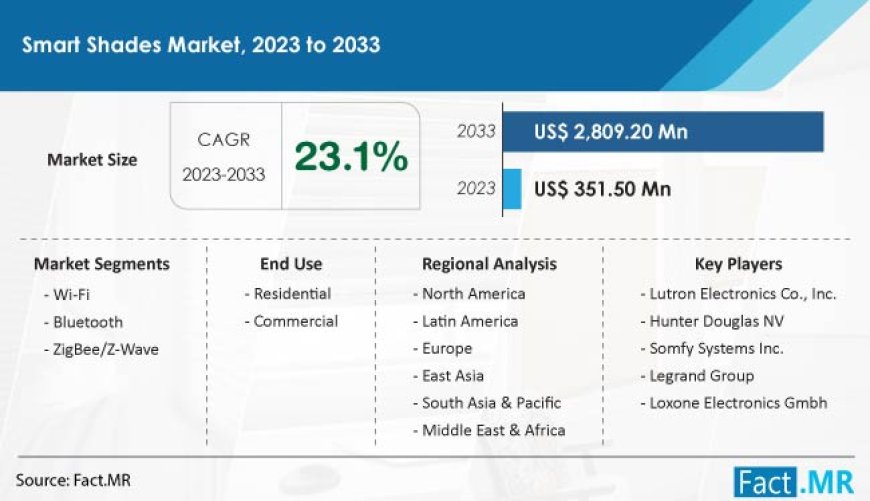Smart Shades Market Demand is Predicted to Skyrocket at a CAGR of 23.1% from 2023 to 2033

As per Fact.MR, a provider of market research and competitive intelligence, the global Smart Shades Market is projected to reach a value of US $2.81 Bn by 2033 while growing at a CAGR of 23.1%.
Smart shades, or motorized window coverings, are technologically advanced solutions for window management. Unlike traditional manual shades, smart shades provide convenience through remote control via smartphones or voice commands. Their automation capabilities allow for scheduled adjustments based on factors like time, sunlight, and temperature, contributing to improved energy efficiency.
For More Insights into the Market, Request a Sample of this Report:
https://www.factmr.com/connectus/sample?flag=S&rep_id=471
Key Segments of Smart Shades Industry Research Report
By Technology : Wi-Fi, Bluetooth, ZigBee/Z-Wave
By Sales Channel : Direct to Customer, Online, Hypermarkets/Supermarkets, Specialty Stores
By End Use : Residential, Commercial
By Region : North America, Latin America, Europe, East Asia, South Asia & Oceania, MEA
Smart shades can seamlessly integrate into smart home systems, offering a holistic control experience alongside other connected devices. Some models even incorporate artificial intelligence for personalized adaptation to user preferences.
The growth of the smart shades market is primarily driven by the increasing demand for energy-efficient and sustainable home solutions. Consumers are drawn to the convenience and automation offered by smart shades, enabling remote control and scheduled adjustments for optimized natural light and temperature.
The installation and setup complexity of smart shades may pose a challenge for users who aren’t tech-savvy. Smart shades, which offer automated features like remote control and integration with smart home systems, require technical know-how during installation. Integration issues with existing smart home ecosystems or devices could hinder seamless operation and user experience.
Key Takeaways:
The German market is expected to witness a CAGR of 23.8% during the forecast period (2023–2033). The smart shades market in the UK market is expected to witness a market value of US $ 171. 4 Mn due to growing demand for smart window solutions.
Moreover, the US is predicted to witness a CAGR of 23.6% during the forecast period. Higher consumer inclination towards high-end technological innovations is expected to contribute to the growth of the market.
Demand for smart shades from the residential sector is expected to advance at 23.2 % during 2033. The energy efficiency of smart shades and customizable automation routines are expected to contribute to the growth of the market.
Get Customization on this Report for Specific Research Solutions:
https://www.factmr.com/connectus/sample?flag=RC&rep_id=471
Market Competition
In this highly competitive market, dominant players are focusing on nurturing a robust digital ecosystem. Key players in the industry include Hunter Douglas NV, Lutron Electronics Co., Inc., Somfy Systems Inc., Graber Blinds, Legrand Group, and Vertilux Ltd., who are spearheading these efforts. To establish a strong foothold in the market, players in the market are incorporating high-end technology into their solutions.
In 2020, Somfy Systems Inc. introduced the Sonesse Ultra 30. This innovation offers a wire-free ZigBee Li-on motor, marking a substantial breakthrough that has the potential to transform the market.
Winning strategies
Key companies should focus on the creation of solar-powered smart shades. These shades are not only environmentally friendly by using solar energy, reducing carbon footprints, and promoting sustainability, but they also offer energy efficiency, potentially lowering electricity bills for users.
Introducing innovative privacy features, such as adjustable opacity and smart zoning, is a strategic move in the market. These features empower users to customize and control the level of privacy in various areas of their homes, addressing a significant concern for consumers adopting smart window treatments.
Integrating light and temperature sensors into their products represents a crucial advancement for leading players. This incorporation allows for automatic adjustments based on ambient conditions, elevating the overall intelligence of the system.

 swatichaudhari
swatichaudhari 










